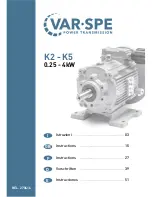
3.4
Section 3
Troubleshooting
If the flywheel end is more accessible, use a
breaker bar and socket on the flywheel nut/screw
to hold it in position. An assistant may be needed
to hold the breaker bar during testing. If the
engine is mounted in a piece of equipment, it may
be possible to hold it by clamping or wedging a
driven component. Just be certain that the engine
cannot rotate off of TDC in either direction.
4. Install the adapter into the spark plug hole, but
do not attach it to the tester at this time.
5. Connect an air source of at least 50 psi to the
tester.
6. Turn the regulator knob in the increase direction
(clockwise) until the gauge needle is in the yellow
set
area at the low end of the scale.
7. Connect the tester quick-disconnect to the
adapter hose while firmly holding the engine at
TDC. Note the gauge reading and listen for
escaping air at the carburetor intake, exhaust
outlet, and crankcase breather.
8. Check the test results against the following table:
Leakdown Test Results
Air escaping from crankcase breather ......................................................Rings or cylinder worn.
Air escaping from exhaust system ............................................................Defective exhaust valve/improper seating.
Air escaping from carburetor .....................................................................Defective intake valve/improper seating.
Gauge reading in
low
(green) zone ............................................................Piston rings and cylinder in good
condition.
Gauge reading in
moderate
(yellow) zone ...............................................Engine is still usable, but there is some
wear present. Customer should start
planning for overhaul or replacement.
Gauge reading in
high
(red) zone ...............................................................Rings and/or cylinder have considerable
wear. Engine should be reconditioned or
replaced.
Compression Test
A compression test is best performed on a warm
engine. Clean any dirt or debris away from the base
of the spark plugs before removing them. Be sure the
choke is off, and the throttle is wide open during the
test. Compression should be at least 160 psi and
should not vary more than 15% between cylinders.
Cylinder Leakdown Test
A cylinder leakdown test can be a valuable
alternative to a compression test. By pressurizing the
combustion chamber from an external air source, you
can determine if the valves or rings are leaking and
how badly.
The Cylinder Leakdown Tester (see Section 2) is a
relatively simple, inexpensive leakdown tester for
small engines. The tester includes a quick disconnect
for attaching the adapter hose, and a holding tool.
Leakdown Test Instructions
1. Run the engine for 3-5 minutes to warm it up.
2. Remove the spark plug(s) and the air filter from
engine.
3. Rotate the crankshaft until the piston (of
cylinder being tested) is at top dead center (TDC)
of the compression stroke. Hold the engine in this
position while testing. The holding tool supplied
with the tester can be used if the PTO end of the
crankshaft is accessible. Lock the holding tool
onto the crankshaft. Install a 3/8" breaker bar
into the hole/slot of the holding tool, so it is
perpendicular to both the holding tool and
crankshaft PTO.
















































